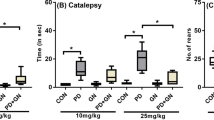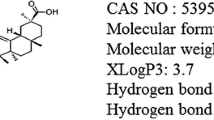Abstract
The present study investigated the neuroprotective effect of curcuminoids, the active polyphenols of Curcuma longa (L.) rhizomes against inflammation-mediated dopaminergic neurodegeneration in the 1-methyl-4-phenyl-1,2,3,6- tetrahydropyridine (MPTP) model of Parkinson’s disease (PD). Male C57BL/6 mice were pre-treated with curcuminoids (150 mg/kg/day) for 1 week, followed by four intra-peritoneal (i.p.) injections of MPTP (20 mg/kg) at 2 h intervals with further administration of curcuminoids or deprenyl (3 mg/kg/day) for 2 weeks. Our results show that oral administration of curcuminoids significantly prevented MPTP-mediated depletion of dopamine and tyrosine hydroxylase (TH) immunoreactivity. In-addition, pre-treatment with curcuminoids reversed glial fibrillary acidic protein (GFAP) and inducible nitric oxide synthase (iNOS) protein expression, as well as, reduced pro-inflammatory cytokine and total nitrite generation in the striatum of MPTP-intoxicated mice. Significant improvement in motor performance and gross behavioural activity, as determined by rota-rod and open field tests were also observed. Taken together, our findings suggest that curcuminoids exert a neuroprotective effect against MPTP-induced dopaminergic neurodegeneration through its anti-inflammatory action and thus holds immense potential as a therapeutic candidate for the prevention and management of PD.







Similar content being viewed by others
References
Ahmed S, Anuntiyo J, Malemud CJ, Haqqi TM (2005) Biological basis for the use of botanicals in osteoarthritis and rheumatoid arthritis: A review. Evid Based Complement Alternat Med 2:301–308
Ben-Shlomo Y, Bhatia K (2004) Using monoamine oxidase type B inhibitors in Parkinson’s disease. Br Med J 329:581–582
Bloem BR, Irwin I, Buruma OJS, Haan J, Roos RAC, Tetrud JW, Langston JW (1990) The MPTP model: versatile contributions to the treatment. J NeurolSci 97:273–293
Cardoso SM, Moreira PI, Agostinho P, Pereira C, Oliveira CR (2005) Neurodegenerative pathways in Parkinson’s disease: therapeutic strategies. Curr Drug Targets CNS Neurol Disord 4:405–419
Chen S, Lee W (2006) Neuroprotective therapy in Parkinson disease. Am J Ther 13:445–457
Dawson VL, Dawson TM, Bartley DA, Uhl GR, Snyder SH (1993) Mechanisms of nitric oxide- mediated neurotoxicity in primary brain cultures. J Neurosci 13:2651–2661
Dehmer T, Lindenau J, Haid S, Dichgans J, Schulz JB (2000) Deficiency of inducible nitric oxide synthase protects against MPTP toxicity in vivo. J Neurochem 74:2213–2216
Gao HM, Liu B, Hong JS (2003a) Critical role of microglia NADPH oxidase-derived free radicals in the MPTP model of Parkinson’s disease. J Neurosci 23:1228–1236
Gao HM, Liu B, Zhang W, Hong JS (2003b) Synergistic dopaminergic neurotoxicity of MPTP and inflammogen lipopolysaccharide: relevance to the etioloy of Parkinson’s disease. FASEB J 17:1957–1971
Gao HM, Liu B, Zhang W, Hong JS (2003c) Novel anti-inflammatory therapy for Parkinson’s disease. Trends Pharmacol Sci 24:395–401
Gilchrist M, Savoie M, Nohara O, Wills FL, Wallace JL, Befus AD (2002) Nitric oxide synthase and nitric oxide production in in vivo-derived mast cells. J Leukocyte Biol 71:618–624
Holcomb LA, Dhanasekaran M, Hitt AR, Young KA, Riggs M, Manyam BV (2006) Bacopa monniera extract reduces amyloid levels in PSAPP mice. J Alzheim Dis 9:243–251
Hunot S, Hartmann A, Hirsch EC (2001) The inflammatory response in the Parkinson brain. ClinNeurosci Res 1:434–443
Jadhav BK, Mahadik KR, Paradkar AR (2007) Development and validation of improved reversed phase-HPLC method for simultaneous determination of curcumin, demethoxycurcumin and bis-demethoxycurcumin. Chromatographia 65:483–488
Jagatha B, Mythri RB, Vali S, Bharath MM (2008) Curcumin treatment alleviates the effects of glutathione depletion in vitro and in vivo: therapeutic implications for Parkinson’s disease explained via in silico studies. Free Radic Biol Med 44:907–917
Kelly MA, Rubinstei M, Phillips TJ, Lessov CN, Burkhart-Kasch S, Zhang G, Bunzon JR, Fang Y, Gerhardt GA, Grandy DK, Low MJ (1998) Locomotor activity in D2 dopamine receptor deficient mice in determined by gene dosage, genetic background and development adaptations. J Neurosci 18:7470–7479
Khuwaja G, Khan MM, Ishrat T, Ahmad A, Raza S, Ashafaq M, Javed H, Khan MB, Khan A, Vaibhav K, Safhi MM, Islam F (2011) Neuroprotective effects of curcumin on 6-hydroxydopamine-induced Parkinsonism in rats: Behavioral, neurochemical and immunohistochemical studies. Brain Res 1368:254–263
Kulkarni SK, Bhutani MK, Bishnoi M (2008) Antidepressant activity of curcumin: involvement of serotonin and dopamine system. Psychopharmacology 201:435–442
Liberatore GT, Jacksons-Lewis V, Vukosavic C, Mandir AS, Vila M, McAuliffe WG (1999) Inducibile nitric oxide synthase stimulates dopaminergic neurodegeneration in the MPTP model of Parkinson’s disease. Nat Med 5:1403–1409
Liu GP, Qiang MA, Shi N (2006) Tyrosine hydroxylase as a target for deltamethrin in the nigrostriatal dopaminergic pathway. Biomed Environ Sci 19:27–34
McGeer EG, McGeer PL (2007) The role of anti-inflammatory agents in Parkinson’s disease. CNS Drugs 21:789–797
McGeer PL, McGeer EG (2008) Glial reactions in Parkinson’s disease. Mov Disord 23:474–483
Minghetti L, Walsh DT, Levi G, Perry VH (1999) In vivo expression of cyclooxygenase-2 in rat brain following intraparenchymal injection of bacterial endotoxin and inflammatory cytokines. J Neuropathol Exp Neurol 58:1184–1191
Morinan A and Garratt HM (1985) An improved fluorimetric assay for brain monoamine oxidase. J Pharmacol Methods 13, 213-223
Nagatsu T, Sawada M (2005) Inflammatory process in Parkinson’s disease: role for cytokines. Curr Pharm Design 11:999–1016
Nagatsu T, Sawada M (2006) Cellular and molecular mechanisms of Parkinson’s disease: neurotoxins, causative genes, and inflammatory cytokines. Cell Mol Neurobiol 26:781–802
Nanji AA, Jokelainen K, Tipoe GL, Rahemtulla A, Thomas P, Dannenberg AJ (2003) Curcumin prevents alcohol-induced liver disease in rats by inhibiting the expression of NF-kappa B-dependent genes. Am J Physiol Gastrointest Liver Physiol 284:G321–G327
Przedborski S, Jackson-Lewis V, Yokoyama R, Shibata T, Dawson VL, Dawson TM (1996) Role of neuronal nitric oxide in 1-methyl-4-phenyl- 1,2,3,6-tetrahydropyridine (MPTP)-induced dopaminergic neurotoxicity. Proc Natl Acad Sci USA 93:4565–4571
Rajeswari A, Sabesan M (2008) Inhibition of monoamine oxidase-B by the polyphenolic compound, curcumin and its metabolite tetrahydrocurcumin, in a model of Parkinson’s disease induced by MPTP neurodegeneration in mice. Inflammopharmacology 16:96–99
Rao CV, Rivenson A, Simi B, Reddy BS (1995) Chemoprevention of colon carcinogenesis by dietary curcumin, a naturally occurring plant phenolic compound. Cancer Res 55:259–266
Rastogi M, Ojha RP, Rajamanickam GV, Agrawal A, Dubey GP (2008) Curcuminoids modulates oxidative damage and mitochondrial dysfunction in diabetic rat brain. Free Radic Res 11:999–1005
Saravanan SK, Sindhu KM, Senthilkumar SK, Mohanakumar KP (2006) L-deprenyl protects against rotenone-induced, oxidative stress-mediated dopaminergic neurodegeneration in rats. Neurochem Int 49:28–40
Sherer TB, Betarbet R, Kim JH, Greenamyre JT (2003) Selective microglial activation in the rat rotenone model of Parkinson’s disease. Neurosci Lett 341:87–90
Sreejayan, Rao MNA (1997) Nitric oxide scavenging by curcuminoids. J Pharm Pharmacol 49:105–107
Sriram K, Matheson JM, Benkovic SA, Miller DB, Luster MI, O’Callaghan JP (2006) Deficiency of TNF receptors suppresses microglial activation and alters the susceptibility of brain regions to MPTP-induced neurotoxicity: role of TNF-α1. FASEB J 20:670–682
Tansey MG, McCoy MK, Frank-Cannon TC (2007) Neuroinflammatory mechanisms in Parkinson’s disease: potential environmental triggers, pathways, and targets for early therapeutic intervention. Exp Neurol 208:1–25
Teismann P, Schulz JB (2004) Cellular pathology of Parkinson’s disease: astrocytes, microglia and inflammation. Cell Tissue Res 318:149–161
Tohda C, Nakayama N, Hatanaka F, Komatsu K. Comparison on anti-inflammatory activities of six Curcuma rhizomes (2006) A possible curcuminoid-independent pathway mediated by Curcuma phaeocaulis extract. Evid Based Complement Alternat Med 3:255–60
Vajragupta O, Boonchoong P, Watanabe H, Tohda M, Kummasud N, Sumanont Y (2003) Manganese complexes of curcumin and its derivatives: Evaluation for the radical scavenging ability and neuroprotective activity. Free Radical Biology & Medicine 35(12):1632–1644
Vijitruth R, Liu M, Choi DY, Nguyen XV, Hunter RL, Bing G (2006) Cyclooxygenase-2 mediates microglial activation and secondary dopaminergic cell death in the mouse MPTP model of Parkinson’s disease. J Neuroinflammation 3:6–6
Wang MS, Boddapati S, Emadi S, Sierks MR (2010) Curcumin reduces α-synuclein induced cytotoxicity in Parkinson’s disease cell model. BMC Neurosci 11:57
Yang S, Zhang D, Yang Z, Hu X, Qian S, Liu J (2008) Curcumin protects dopaminergic neuron against LPS induced neurotoxicity in primary rat neuron/glia culture. Neurochem Res 33:2044–2053
Zbarsky V, Datla KP, Parkar S, Rai DK, Aruoma OI, Dexter DT (2005) Neuroprotective properties of the natural phenolic antioxidants curcumin and naringenin but not quercetin and fisetin in a 6-OHDA model of Parkinson’s disease. Free Radic Res 39:1119–1125
Zhang LJ, Wu CF, Meng XL, Yuan D, Cai XD, Wang QL, Yang JY (2008) Comparison of inhibitory potency of three different curcuminoids pigments on nitric oxide and tumor necrosis factor production of rat primary microglia induced by lipopolysaccharide. NeurosciLett 447:48–53
Acknowledgments
We thankfully acknowledge the Vice Chancellor, SASTRA University, Thanjavur for permitting to carry out the present research work in the Centre for Advanced Research in Indian System of Medicine (CARISM). We are grateful to Prof. Serge Przedborski, (Columbia University, NY, USA) for his generous support in providing relevant literature for MPTP model development. We also extend our heartfelt thanks to Prof. K. Sriram (CDC-NIOSH, WV, US) for kindly revising the manuscript.
Declaration of interest
The authors report no conflicts of interest. The authors alone are responsible for the content and writing of the manuscript.
Author information
Authors and Affiliations
Corresponding author
Rights and permissions
About this article
Cite this article
Ojha, R.P., Rastogi, M., Devi, B.P. et al. Neuroprotective Effect of Curcuminoids Against Inflammation-Mediated Dopaminergic Neurodegeneration in the MPTP Model of Parkinson’s Disease. J Neuroimmune Pharmacol 7, 609–618 (2012). https://doi.org/10.1007/s11481-012-9363-2
Received:
Accepted:
Published:
Issue Date:
DOI: https://doi.org/10.1007/s11481-012-9363-2




